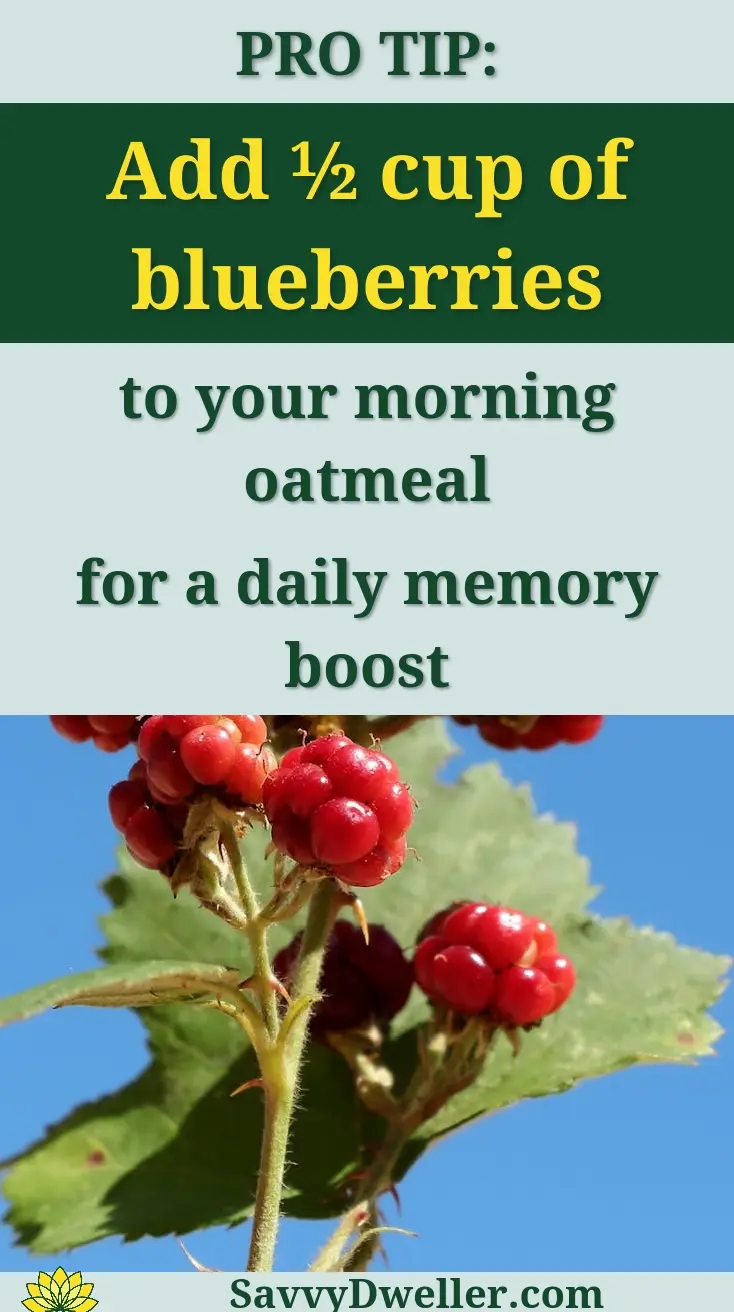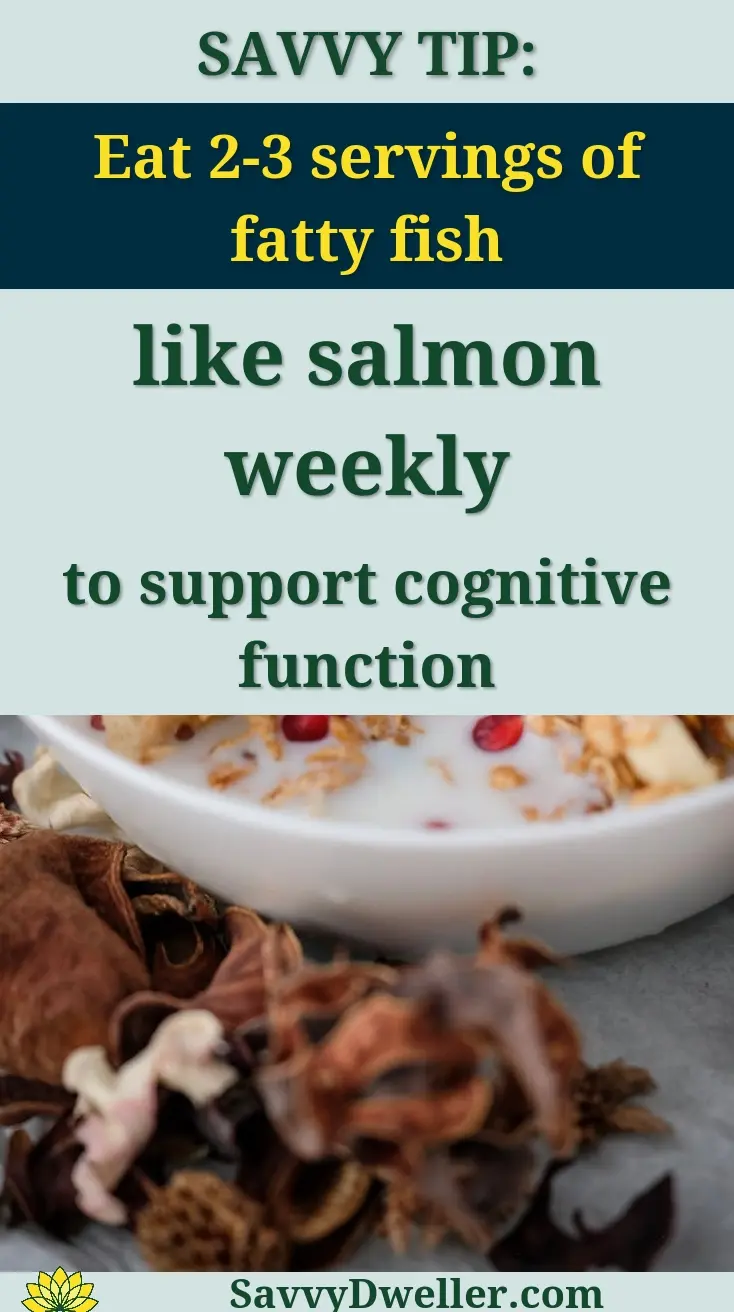7 Brain-boosting Foods to Help Preserve Your Memory
Finding yourself walking into a room and forgetting why you came? Struggling to recall names or misplacing your keys more often than you’d like? You’re not alone, and these moments don’t have to define your future cognitive health.
The foods you choose each day can significantly support your brain’s ability to form and preserve memories. We’ve researched the science behind memory-supporting nutrition and simplified it into practical, everyday solutions. This guide reveals seven delicious foods that may help keep your mind sharp, along with simple ways to incorporate them into meals you’ll actually enjoy.
Contents
- At a Glance: The Best Brain-boosting Foods
- The Science Made Simple: Why Memory-supporting Foods Matter
- 1. Fatty Fish: Your Brain’s Best Friend
- 2. Blueberries: Nature’s Memory Enhancers
- 3. Leafy Greens: Fuel for Your Mind
- 4. Walnuts: Tiny Powerhouses for Brain Health
- 5. Dark Chocolate: A Sweet Path to Better Memory
- 6. Turmeric: Golden Spice for Memory Support
- 7. Avocados: Creamy Support for Cognitive Function
- Common Mistakes to Avoid When Building a Memory-supporting Diet
- Frequently Asked Questions
- Final Words
At a Glance: The Best Brain-boosting Foods
When you’re looking for foods that boost memory and support cognitive function, these seven powerhouses stand out as research-backed options. Each food offers unique brain-supporting nutrients that may aid in memory preservation and overall cognitive health.
This quick reference table shows you exactly what makes each food special and how to include them in your daily routine. You don’t need complicated meal plans or expensive supplements-just simple, whole foods that taste great and support your brain naturally.
| Food | Key Brain-Supporting Nutrients | Memory Benefits | Easy Ways to Add to Diet |
|---|---|---|---|
| Fatty Fish | Omega-3 fatty acids (DHA, EPA) | Supports cognitive function and neural health | 2-3 servings weekly, grilled or baked |
| Blueberries | Anthocyanins, antioxidants | May aid memory and concentration | ½ cup daily in smoothies or oatmeal |
| Leafy Greens | Folate, vitamin K, lutein | Supports brain health and cognitive function | 2-3 cups daily in salads or smoothies |
| Walnuts | Omega-3s, vitamin E | May support memory and brain health | 1 oz (handful) as snack or in meals |
| Dark Chocolate | Flavonoids, caffeine | May aid focus and cognitive function | 1-2 squares (70%+ cacao) daily |
| Turmeric | Curcumin | Supports brain health and memory | 1 tsp daily in cooking or golden milk |
| Avocados | Monounsaturated fats, vitamin K | Supports healthy blood flow to brain | ½ avocado daily in meals or snacks |
Notice how these memory preservation foods work through different pathways-some provide essential fatty acids, others deliver powerful antioxidants, and several support healthy blood flow to your brain. The beauty lies in their simplicity and accessibility.
You can start with just one or two foods from this list and gradually add others as they become part of your routine. The key is consistency rather than perfection, making these brain foods memory allies a natural part of your daily eating pattern.
The Science Made Simple: Why Memory-supporting Foods Matter
Your brain works around the clock, and just like any hardworking organ, it needs the right fuel to perform at its best. Brain-boosting foods contain specific nutrients that help maintain cognitive function and support memory preservation as we age.
Think of your brain like a sophisticated computer that needs quality parts to run smoothly. The foods you choose directly impact how well your memory works and how sharp your thinking stays over time.
How Brain-boosting Nutrients Work
Memory preservation foods work through several pathways in your body. They provide building blocks for brain cells, protect against damage, and support the communication networks that make thinking and remembering possible.
The Role of Antioxidants in Brain Health
Antioxidants act like a shield for your brain, protecting it from harmful free radicals that can damage memory-forming cells. These compounds neutralize oxidative stress, which naturally increases as we age and can interfere with cognitive function.
Foods rich in antioxidants help maintain the integrity of brain tissue. They support the delicate structures where memories form and strengthen the connections between brain cells.
Essential Fatty Acids and Neural Function
Your brain is nearly 60% fat, making healthy fats crucial for optimal function. Omega-3 fatty acids, particularly DHA and EPA, form the structural foundation of brain cell membranes.
These essential fats keep brain cell membranes flexible and efficient. This flexibility allows nutrients to flow in and waste products to flow out, supporting clear thinking and memory formation.
Understanding Memory Preservation Through Nutrition
Food for brain memory improvement works through multiple mechanisms that scientists continue to study. The key lies in consistent nutrition that supports your brain’s natural maintenance and repair processes.
Blood Flow and Cognitive Function
Proper blood flow delivers oxygen and nutrients to brain cells while removing waste products that can interfere with memory. Many foods that boost memory work by supporting healthy circulation to the brain.
When blood flow improves, your brain receives a steady supply of glucose for energy and essential nutrients for repair. This enhanced delivery system helps maintain sharp thinking and supports new memory formation.
Inflammation and Brain Health Connection
Chronic inflammation can interfere with memory pathways and cognitive function. Foods for improving memory often contain compounds that help reduce inflammation in brain tissue.
Low-grade inflammation can disrupt the signals between brain cells and impair the formation of new memories. Anti-inflammatory nutrients help maintain clear communication channels in your brain.

1. Fatty Fish: Your Brain’s Best Friend
Fatty fish stands out as one of the most powerful brain foods memory research has identified. These swimming sources of nutrition provide omega-3 fatty acids that your brain craves for optimal function.
Regular consumption of fatty fish has been linked to better cognitive performance and slower age-related memory decline. The unique combination of nutrients makes this food category particularly valuable for brain health.
Why Omega-3 Fatty Acids Support Memory
Omega-3s serve as building blocks for brain cell membranes and support the production of neurotransmitters. These essential fats help maintain the flexibility and function of brain cells responsible for forming and retrieving memories.
DHA and EPA Benefits for Brain Health
DHA (docosahexaenoic acid) makes up a significant portion of brain tissue and is particularly concentrated in areas responsible for memory. EPA (eicosapentaenoic acid) supports brain health by reducing inflammation and supporting mood regulation.
Together, these omega-3s help maintain the structural integrity of brain cells. They also support the production of BDNF, a protein that promotes the growth of new brain cells and connections.
Best Types of Fish for Memory Support
Salmon, mackerel, sardines, and anchovies provide the highest concentrations of memory-supporting omega-3 fatty acids. These cold-water fish naturally accumulate these beneficial fats in their tissues.
- Wild-caught salmon (highest in DHA and EPA)
- Mackerel (excellent omega-3 to mercury ratio)
- Sardines (sustainable and affordable option)
- Anchovies (versatile and nutrient-dense)
- Rainbow trout (mild flavor, good for beginners)
Simple Ways to Add More Fatty Fish to Your Diet
Including food for brain memory in your routine doesn’t require complicated cooking skills. Start with simple preparations that preserve the natural flavors and nutrients.
Easy Preparation Methods for Seniors
Baking, poaching, and pan-searing require minimal effort while preserving maximum nutritional value. These gentle cooking methods prevent the breakdown of delicate omega-3 fatty acids.
- Season fish fillets with lemon, herbs, and olive oil
- Bake at 375°F for 12-15 minutes depending on thickness
- Check for doneness when fish flakes easily with a fork
- Serve immediately to preserve texture and flavor
Portion Sizes and Frequency Guidelines
Aim for two 3.5-ounce servings of fatty fish per week to support optimal brain health. This amount provides sufficient omega-3s without exceeding mercury safety guidelines.
A serving size equals about the size of your palm. Spreading these servings throughout the week helps maintain steady levels of brain-supporting nutrients.
Quick Recipe: Herb-crusted Salmon
This simple preparation method maximizes flavor while preserving the memory-supporting nutrients in salmon.
- Preheat oven to 400°F
- Mix 2 tablespoons chopped fresh dill, 1 tablespoon olive oil, and minced garlic
- Place 4 salmon fillets on parchment-lined baking sheet
- Spread herb mixture over salmon
- Bake 12-15 minutes until fish flakes easily
- Serve with lemon wedges and steamed vegetables
Also See: 6 Best Foods to Help Women Lose Belly Fat
2. Blueberries: Nature’s Memory Enhancers
Blueberries earn their reputation as one of the top foods that improve memory and concentration through their unique combination of antioxidants. These small berries pack a powerful punch of brain-supporting compounds in every bite. Incorporating blueberries into your diet is a great step towards enhancing cognitive function naturally. Healthy foods like these not only support memory but also help you focus better throughout the day.
Research suggests regular blueberry consumption may help slow age-related cognitive decline. The deep blue color signals high levels of anthocyanins, the compounds responsible for many brain benefits.
How Anthocyanins Aid Cognitive Function
Anthocyanins are flavonoid compounds that give blueberries their distinctive color. These powerful antioxidants cross the blood-brain barrier and accumulate in brain regions important for memory and learning.
Once in the brain, anthocyanins help protect neurons from oxidative stress and support communication between brain cells. They may also stimulate the growth of new neural pathways.
The Power of Antioxidants in Berries
Blueberries contain one of the highest antioxidant levels of any common fruit, making them exceptional brain boosting food choices. These antioxidants neutralize free radicals that can damage brain cells over time. Consuming blueberries not only benefits brain health but also provides numerous other health advantages. From improving heart health to enhancing digestion, blueberries pack a punch with their many health benefits.
The combination of anthocyanins, vitamin C, and other antioxidants creates a protective shield around brain cells. This protection helps maintain the cellular machinery responsible for forming and storing memories.
Fresh vs. Frozen: Which is Better?
Both fresh and frozen blueberries provide similar levels of memory-supporting nutrients, making frozen berries a convenient and cost-effective option. Freezing actually breaks down cell walls, potentially making some antioxidants more bioavailable.
Choose fresh berries when in season for optimal flavor and texture. Frozen berries work perfectly in smoothies, baked goods, and cooked dishes while providing year-round brain benefits.
Creative Ways to Enjoy Blueberries Daily
Incorporating these memory foods into your daily routine becomes enjoyable when you explore different preparation methods and combinations.
Morning Smoothie Ideas
Blending blueberries with other brain-supporting ingredients creates a powerful morning boost for cognitive function. The liquid form makes nutrients easily absorbed by your body.
- Blueberry-spinach smoothie with Greek yogurt
- Mixed berry blend with walnuts and flaxseed
- Blueberry-banana smoothie with almond butter
- Green tea and blueberry antioxidant blend
Snack and Dessert Options
Simple preparations let the natural sweetness shine while preserving brain-boosting compounds. Fresh blueberries paired with nuts or yogurt create satisfying snacks that support memory function.
- Blueberries with almonds or walnuts
- Greek yogurt topped with berries and honey
- Frozen blueberries as a cool summer treat
- Blueberry compote over oatmeal or whole grain toast
Quick Recipe: Brain-boosting Berry Bowl
This nutrient-dense bowl combines multiple memory-supporting ingredients for maximum brain benefits.
- Layer 1 cup Greek yogurt in serving bowl
- Top with ½ cup fresh blueberries
- Sprinkle 2 tablespoons chopped walnuts
- Add 1 tablespoon ground flaxseed
- Drizzle with 1 teaspoon honey
- Garnish with mint leaves if desired
3. Leafy Greens: Fuel for Your Mind
Essential Nutrients in Dark Leafy Greens
Folate and Brain Health Connection
Folate supports the production of neurotransmitters that your brain uses for learning and memory. Low folate status can make you feel mentally sluggish, while steady intake from leafy greens adds gentle, daily support.
Spinach, romaine, and Swiss chard are rich folate sources-simple, reliable brain foods memory lovers keep in rotation. Pair greens with beans or eggs to create foods that improve memory and concentration through solid nutrient synergy.
Vitamin K and Cognitive Support
Vitamin K works behind the scenes to support brain cell structure and normal signaling. Kale, collards, and spinach provide vitamin K along with lutein, a carotenoid linked with cognitive performance.
Because vitamin K and lutein are fat-soluble, add a drizzle of extra-virgin olive oil or avocado to boost absorption. This turns everyday salads into memory foods and brain-boosting foods you can count on.
Best Leafy Greens for Memory Preservation
Spinach, Kale, and Arugula Benefits
- Spinach: Folate, vitamin K, and lutein for steady cognitive support; mild taste makes it easy to blend into smoothies-true foods for memory.
- Kale: Vitamin K powerhouse with fiber and polyphenols; sautés well with garlic for savory foods that boost memory without fuss.
- Arugula: Peppery leaves rich in natural nitrates that support healthy blood flow, a helpful path for foods improving memory and focus.
Mixing these greens balances flavor and nutrients. Variety ensures you’re getting brain foods that improve memory in complementary ways.
Tips for Buying and Storing Greens
- Choose crisp leaves with vibrant color; skip yellowing or slimy bunches.
- Rinse, spin dry, and store in a container lined with a paper towel to reduce moisture.
- Keep in the fridge crisper; eat tender greens within 3–5 days, sturdier greens (kale/collards) within a week.
- Chop right before eating to limit nutrient loss, and add a little healthy fat for better absorption-easy food for brain memory improvement.
Quick Recipe: Memory-supporting Green Smoothie
- 2 cups spinach or kale (packed)
- 1/2 cup frozen blueberries
- 1/2 small avocado
- 1 tbsp ground flaxseed or chia
- 1 cup unsweetened kefir or fortified almond milk
- 1/2 cup cold water or ice
- Optional: 1 tsp fresh lemon juice, pinch of cinnamon
- Wash greens and pat dry. Add to blender with liquids.
- Add avocado, berries, and seeds. Blend until silky.
- Taste and brighten with lemon, then serve cold.
This smoothie layers lutein, folate, and healthy fats-practical foods for brain memory that fit busy mornings. Keep pre-washed greens and frozen fruit ready for a 2-minute brain boosting food you’ll actually use.

4. Walnuts: Tiny Powerhouses for Brain Health
Why Walnuts Support Cognitive Function
Plant-Based Omega-3s in Action
Walnuts deliver ALA, a plant omega-3 that your body can convert in small amounts to DHA and EPA. ALA supports healthy inflammation balance, a foundation for foods that help to preserve memory.
One ounce (about 14 halves) provides roughly 2.5 g ALA-solid support for foods for boosting memory that fit any eating style.
Vitamin E and Brain Protection
Vitamin E acts like a shield for cell membranes, including those in your brain. Walnuts supply vitamin E plus polyphenols that work together to combat everyday oxidative stress.
This gentle protection makes walnuts steady players among best foods for brain memory and foods that boost memory over time. Including walnuts in your diet is a delightful way to enhance your brain function. When considering the myriad of health benefits they offer, walnuts stand out among other nuts.
How to Include Walnuts in Your Daily Routine
- Stir into oatmeal or yogurt with cinnamon for easy foods for brain memory.
- Blend into walnut pesto (walnuts, basil, olive oil, garlic, lemon) for pasta or grain bowls.
- Toss on salads with leafy greens and berries-stacking memory preservation foods.
- Make walnut “crumbs” by pulsing with oats and paprika for a crunchy topping on veggies or fish.
- Spread walnut butter on apple slices for a quick food that helps with memory and satiety.
Proper Portion Sizes for Optimal Benefits
Aim for 1 ounce daily-about a small handful or 1/4 cup. This keeps calories in check while delivering consistent ALA and vitamin E.
Rotate nuts to keep variety: walnuts, almonds, pistachios. Variety keeps your list of memory foods balanced and enjoyable.
Storage Tips to Maintain Freshness
- Keep walnuts in an airtight container away from heat and light; oxygen and warmth speed rancidity.
- Refrigerate for up to 6 months or freeze for up to 1 year for peak flavor.
- Smell before eating; a paint-like odor means the fats have oxidized-time to replace.
Quick Recipe: Walnut-crusted Chicken
- 1 lb chicken cutlets
- 1 cup finely chopped walnuts
- 1/2 cup whole-grain breadcrumbs (or oat flour for gluten-free)
- 1 tsp smoked paprika, 1/2 tsp garlic powder, pinch of salt
- 1 egg (or 3 tbsp plain yogurt) for coating
- Olive oil spray
- Heat oven to 400°F (or air fryer to 380°F). Line a sheet pan with parchment.
- Mix walnuts, breadcrumbs, paprika, garlic, and salt in a shallow bowl.
- Whisk egg (or yogurt). Dip chicken to coat, press into walnut mixture.
- Place on pan, lightly oil-spray the tops, and bake 12–15 minutes until the thickest part reaches 165°F.
This dish pairs protein with plant omega-3s-smart food for memory and satisfying crunch in one pan. Serve over arugula for a two-in-one brain boosting foods combo.
5. Dark Chocolate: A Sweet Path to Better Memory
Flavonoids and Their Brain-supporting Properties
Cacao Content: What Percentage to Choose
Look for 70–85% cacao to get more flavanols and less sugar. This range balances taste and potency, turning a square or two into practical foods for brain memory.
Higher cacao usually means more bitter notes, but also more of the compounds tied to attention and working memory-ideal foods that increase memory potential when enjoyed consistently.
How Dark Chocolate Aids Blood Flow
Flavanols in cocoa support nitric oxide pathways, which help blood vessels relax. Better circulation supports oxygen and nutrient delivery to the brain, a core need for foods improving memory and concentration.
Dark chocolate also contains small amounts of caffeine and theobromine for a gentle lift—nice before an afternoon study session, not right before bed. The benefits of dark chocolate extend beyond just keeping you awake; it is packed with nutrients and antioxidants that can contribute positively to your health. Many people enjoy dark chocolate not only for its rich flavor but also for its potential health advantages, making it worth exploring the top 10 benefits of dark chocolate for your well-being.
Enjoying Dark Chocolate Mindfully
Recommended Daily Amounts
Stick to 10–20 g daily (about 1–2 small squares) of 70%+ dark chocolate. This gives you the flavanols without overdoing sugar or calories.
Pair with nuts or yogurt to slow absorption and create a more satisfying snack-easy foods for brain memory improvement that fit real life.
Choosing Quality Over Quantity
- Scan labels for cocoa mass listed before sugar; fewer additives is better.
- Rotate brands and origins to balance flavor and mineral content.
- Store in a cool, dark place (60–70°F) to protect delicate flavanols.
Quality chocolate tastes richer, so smaller portions feel abundant. That’s a win for best foods for memory and mindful eating.
Quick Recipe: Dark Chocolate Energy Bites
- 1 cup rolled oats
- 1/2 cup nut butter (walnut or almond)
- 1/4 cup dark chocolate (70%+), finely chopped or mini chips
- 2 tbsp chia or ground flaxseed
- 2 tbsp honey or pure maple syrup
- Pinch of salt, 1/2 tsp vanilla, optional orange zest
- Stir all ingredients in a bowl until evenly combined.
- Chill 15 minutes, then roll into 12–14 bite-sized balls.
- Refrigerate in a sealed container for up to 1 week.
Each bite blends cocoa flavanols, fiber, and healthy fats-portable foods that boost memory without a sugar crash. Keep a few in the fridge for a calm, focused afternoon.
6. Turmeric: Golden Spice for Memory Support
Curcumin’s Role in Brain Health
Anti-Inflammatory Properties and Memory
Curcumin, the bright pigment in turmeric, may help soothe chronic, low-grade inflammation linked with cognitive decline. It supports your brain’s natural defense systems by moderating inflammatory signals and neutralizing free radicals. This powerful compound also boasts a range of benefits for overall health. Exploring the 10 amazing health benefits of turmeric curcumin can provide insights into how it enhances well-being beyond just cognitive function.
That dual action-anti-inflammatory plus antioxidant-makes turmeric a smart pick among brain-boosting foods. It fits well within a pattern of foods that improve memory and concentration.
Bioavailability Tips with Black Pepper
Curcumin is hard for the body to absorb on its own, so pair it with both fat and black pepper for a boost. Piperine in black pepper can significantly increase absorption, and a little oil helps curcumin dissolve and travel better in your system. Interestingly, combining spices like cayenne pepper with curcumin can also enhance absorption and provide unexpected health benefits. Cayenne pepper is known for its potential to improve metabolism and reduce inflammation, making it a great addition to your health regimen.
Practical combo ideas: turmeric + olive oil in sautéed veggies, or turmeric + milk and a pinch of pepper in a warm latte. This simple pairing turns turmeric into a more effective food for brain memory improvement.
Easy Ways to Add Turmeric to Meals
Golden Milk and Warm Beverages
Warm liquids help turmeric disperse evenly, making it easy to sip your memory-supporting blend. Try it in golden milk, ginger-turmeric tea, or a cinnamon turmeric cocoa with a pinch of pepper.
- Stir 1/2–1 tsp turmeric into warmed dairy or plant milk.
- Add a pinch of black pepper and 1 tsp coconut oil or ghee.
- Sweeten lightly with honey or maple, if you like.
Cooking with Turmeric Safely
Bloom turmeric gently in oil for 30–60 seconds to release aroma without burning. High heat can turn it bitter and reduce flavor appeal.
- Use 1/2–1 tsp per dish for color and balance; more can taste earthy.
- Add late in cooking soups or stews to preserve flavor and color.
- Turmeric stains-use a dedicated spoon and wipe spills quickly.
Quick Recipe: Turmeric Golden Milk Latte
- 1 cup milk (dairy or unsweetened almond/oat)
- 1/2 tsp ground turmeric (or 1 tsp freshly grated)
- 1/8 tsp ground cinnamon
- Pinch black pepper
- 1/2 tsp coconut oil or ghee
- 1–2 tsp honey or maple syrup (optional)
- Optional: small slice fresh ginger or 1/8 tsp ground ginger
- Warm milk in a small pot over low heat.
- Whisk in turmeric, cinnamon, pepper, and coconut oil. Add ginger if using.
- Simmer 3–5 minutes, stirring, until steamy but not boiling.
- Sweeten to taste. Strain if using fresh ginger. Sip warm.
This soothing latte is a simple food for memory-easy to make, calm to drink, and designed for better curcumin absorption.
7. Avocados: Creamy Support for Cognitive Function
Monounsaturated Fats and Brain Health
Supporting Healthy Blood Flow
Avocados provide monounsaturated fats that support flexible blood vessels and steady blood flow to the brain. Better circulation means oxygen and nutrients reach brain cells more efficiently, a key part of foods that boost memory. Incorporating avocados into your diet not only enhances brain function but also delivers numerous health benefits. From improving heart health to aiding digestion, avocados are a powerhouse of nutrition that can elevate overall well-being.
That steady flow pairs well with other memory foods like leafy greens and walnuts in a balanced plate. This is one reason avocados rank among best foods for memory in everyday meals.
Additional Vitamins and Minerals
Avocados also supply folate, potassium, fiber, and lutein-nutrients tied to brain function and long-term memory support. Folate helps with methylation processes, while potassium aids healthy blood pressure, which supports brain perfusion.
Lutein concentrates in neural tissue and may aid processing speed. Fiber helps keep blood sugar steadier, which supports focus and attention.
Simple Avocado Preparation Ideas
Beyond Toast: Creative Uses
- Mash with lemon, herbs, and pepper as a creamy topper for grilled salmon or chickpeas.
- Blend 1/4 avocado into a smoothie for silky texture and steady energy.
- Dice into grain bowls with quinoa, roasted veggies, and a turmeric vinaigrette.
- Swap mayo: use mashed avocado in egg salad or tuna for a brain-boosting food upgrade.
Ripeness and Storage Guidelines
Check ripeness with gentle pressure near the stem-slight give means ready. If the stem nub pops off to reveal green, it’s good; brown signals overripe.
- Unripe: keep at room temp; speed it up by placing with a banana in a paper bag.
- Ripe: refrigerate whole avocados for 2–3 days.
- Cut: sprinkle with lemon, wrap tightly, and refrigerate; or mash with lemon and freeze for up to a month.
Quick Recipe: Avocado and Walnut Salad
- 2 cups arugula or mixed greens
- 1/2 ripe avocado, diced
- 1/4 cup walnuts, lightly toasted
- 1/4 cup cherry tomatoes, halved
- 2 tbsp crumbled feta (optional)
- 1 tbsp extra-virgin olive oil
- 2 tsp lemon juice
- 1/2 tsp Dijon mustard
- Pinch salt and black pepper
- Whisk olive oil, lemon juice, mustard, salt, and pepper.
- Toss greens with dressing until lightly coated.
- Top with avocado, walnuts, tomatoes, and feta. Serve immediately.
This crunchy-creamy bowl layers monounsaturated fats, ALA from walnuts, and leafy greens-smart foods for boosting memory in one fast plate.
Common Mistakes to Avoid When Building a Memory-supporting Diet
Expecting Immediate Results
Nutrition supports memory over weeks and months, not days. Think consistency: aim for daily patterns of brain foods memory plans-like regular leafy greens, omega-3s, berries, turmeric, walnuts, dark chocolate, and avocados.
Focusing on Single Foods Instead Of Overall Pattern
No single food that helps with memory works in isolation. Build balanced meals that combine multiple foods improving memory-healthy fats, colorful produce, quality protein, and fiber.
- Example plate: salmon + kale salad + quinoa + turmeric dressing + a square of dark chocolate.
Ignoring Portion Sizes and Balance
Even the best foods for brain memory can overshoot calorie needs if portions are too large. Practical ranges: 1/2 avocado, 1 oz walnuts, 1–2 squares dark chocolate, 1 tsp turmeric in cooking.
- Use the plate method: half veggies, quarter protein, quarter whole grains, plus a small portion of healthy fats.
Not Considering Food Interactions and Timing
Small timing tweaks can improve how your body uses brain boosting food. Pair turmeric with pepper and fat; have iron-rich meals with vitamin C; space coffee or tea 1–2 hours away from iron-rich meals.
If you take medications or manage health conditions, check with a healthcare professional about possible interactions (for example, piperine may affect how some drugs are processed).
Overlooking Hydration and Other Lifestyle Factors
Dehydration can dull focus and memory, even when you’re eating the best foods for brain memory. Aim for regular fluids throughout the day from water, unsweetened tea, soups, and water-rich produce.
Sleep, movement, and stress management work alongside foods for memory. Think of them as partners to your memory preservation foods, not extras.

Frequently Asked Questions
How Can I Easily Incorporate These Brain-boosting Foods Into a Busy Schedule?
Incorporating these foods into a busy lifestyle is simpler than you might think. Focus on prep-ahead strategies, such as washing and portioning leafy greens for quick salads, or keeping a container of walnuts and dark chocolate squares for on-the-go snacks. For example, blend frozen blueberries into morning smoothies the night before, or batch-cook fatty fish like salmon to add to meals throughout the week.
Are There Any Food Combinations That Maximize the Memory Benefits?
Yes, certain combinations can enhance nutrient absorption and effectiveness. Pair turmeric with a pinch of black pepper to significantly boost curcumin bioavailability, as found in golden milk recipes. Similarly, combining healthy fats from avocados with vitamin-rich leafy greens in a salad can improve the absorption of fat-soluble vitamins like vitamin K, supporting overall brain health.
What Should I Look for When Shopping for These Foods to Ensure Quality?
Prioritize freshness and purity to get the most benefits. Choose wild-caught fatty fish like salmon over farmed varieties when possible, and opt for dark chocolate with at least 70% cacao to minimize added sugars. For berries, select vibrant, plump blueberries-frozen can be just as nutritious if fresh isn’t available. Always check labels for organic or non-GMO options if concerned about pesticides.
Can These Foods Be Beneficial for People Of All Ages, or Are They Primarily for Older Adults?
These foods support brain health at any age. Young adults and children can benefit from early incorporation to build cognitive reserves, as nutrients like omega-3s from walnuts or fatty fish aid neural development. However, consistency is key; making them part of a lifelong diet helps maintain memory function as you age, rather than being a quick fix for seniors alone.
Final Words
Nourishing your brain doesn’t require complicated meal plans or expensive supplements. These seven brain-boosting foods offer a simple, delicious path to supporting your memory and cognitive health as you age. The best part? You can start today with just one small change-adding a handful of walnuts to your morning oatmeal or swapping your afternoon snack for a square of dark chocolate.
Remember, consistency trumps perfection when it comes to memory-supporting nutrition. Your brain thrives on steady, long-term nourishment rather than dramatic dietary overhauls. Focus on gradually incorporating these foods into meals you already enjoy, and let the natural compounds work their magic over time.
Ready to give your memory the nutritional support it deserves? Start with one or two foods from our list this week and build from there. For more practical wellness tips and home solutions that support your healthiest life, visit Savvy Dwelling and stay connected with our community of health-conscious readers just like you.


